

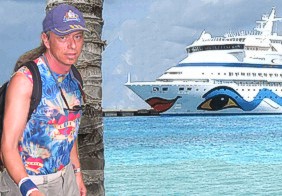
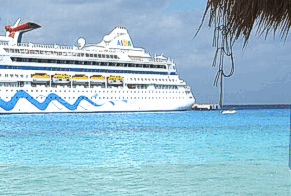
Caribbean Sea 2002 (coming soon) and Central
America 2004
In the last two years I visited a lot of small
countries around the Caribbean Sea. On this page I'd like to give you my impressions of
them.
Central America 2004
After a flight from Germany, with a brilliant
clear-weather view when we flew over New York, our plane landed on Bob Marley's Island
Jamaica. We started our Carribean trip hours later when we boarded the cruise liner AIDA
at Montego Bay. Our first port of call was San Miguel, a harbour on
the Mexican Isla Cozumel.
It was the first touch back to a relaxed life,
endless beaches, palm trees, sunny weather and mysterious animal sounds coming out of the
tropical rainforest. After one day we left Mexico for Belize, formerly known as British
Honduras.
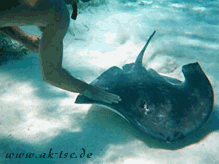 The ship anchored outside the harbour of Belize
city. With a speedboat, I travelled one hour into the second largest reef of the world to
a place called Shark Ray Alley. In the middle of the sea you can dive with hundreds of
Sting Rays and harmless Sharks. The unbelievable thing is that you can
The ship anchored outside the harbour of Belize
city. With a speedboat, I travelled one hour into the second largest reef of the world to
a place called Shark Ray Alley. In the middle of the sea you can dive with hundreds of
Sting Rays and harmless Sharks. The unbelievable thing is that you can
touch and hold these big animals. It's a strange feeling, some of them are bigger than me.
Another crazy thing was that a billionaire from Kentucky built a golf-course in that area.
Big ships brought tonnes of sand from the USA to fulfil the dream of that crazy guy.
The next day we arrived in Puerto Cortez, Honduras - beautiful
sleepy village with long beaches. We took the chance for some swimming and walking around
this republic. A tip for women, reading this page, shoe-shopping is very cheap here. The
country was devastated by Hurricane Mitch in 1998,
which killed about 5,600 people and caused almost $1 billion in damage. At some places you
still see that disaster.
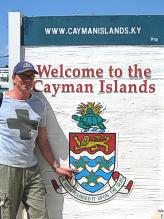 From there, our ship went to George Town on
Grand Cayman, a island group in the Caribbean Sea, nearly one-half of the way from Cuba to
Honduras The Cayman Islands were colonised from Jamaica by the British during the 18th and
19th centuries. Administered by Jamaica since 1863, it remained a
From there, our ship went to George Town on
Grand Cayman, a island group in the Caribbean Sea, nearly one-half of the way from Cuba to
Honduras The Cayman Islands were colonised from Jamaica by the British during the 18th and
19th centuries. Administered by Jamaica since 1863, it remained a
British dependency after 1962 when the former became independent.
Beautiful, but very expensive. Nearly every big bank has an office in this tax paradise.
After a sunny day, the ship brought us back to Montego Bay, Jamaica,
where we watched a local game after some swimming in the clear blue water. The reggae boys
are crazy for football.
After one and a half day of heavy seas, our second week started in
Puerto Limon, Costa Rica. Costa Rica is a Central American success story: since the late
19th century, only two brief periods of violence have marred its democratic development.
Although still a largely agricultural country, it has expanded its economy to include
strong technology and tourism sectors. The standard of living is relatively high. We
walked around the small town and took a bike tour into the rainforest. Everywhere big
vultures flying around and I was happy not to have an accident. I destroyed their hopes of
some German meat.
 The next day we arrived in Cristobal, Panama. We used our time for a trip
to the Canal. The entire Panama Canal, the area supporting the Canal, and remaining US
military bases were turned over to Panama on 31 December 1999. It was impressive to watch
the big ships travelling through the Canal.
The next day we arrived in Cristobal, Panama. We used our time for a trip
to the Canal. The entire Panama Canal, the area supporting the Canal, and remaining US
military bases were turned over to Panama on 31 December 1999. It was impressive to watch
the big ships travelling through the Canal.
Sometimes they have less than a metre either side of them when they sail through.
But we did not go into the closest big town: Colon, too dangerous for strangers, they told
us. However, another highlight was that the Queen Mary 2 was in the harbour with us.
Over night, after we left Panama, our ship went to Colombia. Welcome to one of the most
beautiful colonial cities in America: Cartagena de Indias.
Cartagena, "Pearl of the Caribbean", has
long been a city of legendary fame. It was here that the incredible riches of the New
World were shipped to Europe. Pirates and raiders like Sir Francis Drake and Henry Morgan
had attacked the city countless times. The Spanish built beautiful mansions and
palaces here, and guarded the city with massive ramparts and fortresses.
The city was among the earliest to rise up against the Spaniards in the South American
struggle for freedom, and Simon Bolivar began one of his campaigns here. Now, the historic
centre of Cartagena is protected by UNESCO as World Heritage. A must to see.
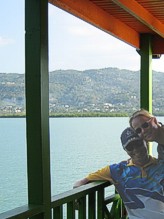 Back
on the sea, two days later we'd reached Ochos Rios on Jamaica. With its wonderful beaches
and high waterfalls, this town is one of the best parts of the island. We spent our last
relaxing hours, saw a beautiful sunset, and on the next day we left the island.
Back
on the sea, two days later we'd reached Ochos Rios on Jamaica. With its wonderful beaches
and high waterfalls, this town is one of the best parts of the island. We spent our last
relaxing hours, saw a beautiful sunset, and on the next day we left the island.
We returned to Montego Bay, and then left the Carribean by plane, back to cold,
good old Germany.
One day, if you find the time and... of course the money, you have to travel to Central
America, not only because of the beautiful beaches and the emerald green water. The people
there are wonderful and very friendly. They show you that you are more than welcome, and I
am sure to go back one day.
The world is so beautiful, why can't we live in peace all
together?
| 1,521 nautical Miles, nearly 2,817 km (1 nm = 1,852 km) |
1,700 nautical Miles, nearly 3,148 km (1 nm = 1,852 km) |
| Montego Bay - Cozumel: 553 sm | Montego Bay - Costa Rica 605 sm |
| Cozumel - Belize City 205 sm | Puerto Limon, Costa Rica - Panama 186 sm |
| Belize City - Puerto Cortez, Honduras 115 sm | Panama - Cartagena, Columbia 275 sm |
| Puerto Cortez - Grand Cayman 435 sm | Cartagena - Ochos Rios, Jamaica 557 sm |
| Grand Cayman - Montego Bay 213 sm | Ochos Rios - Montego Bay 77 sm |
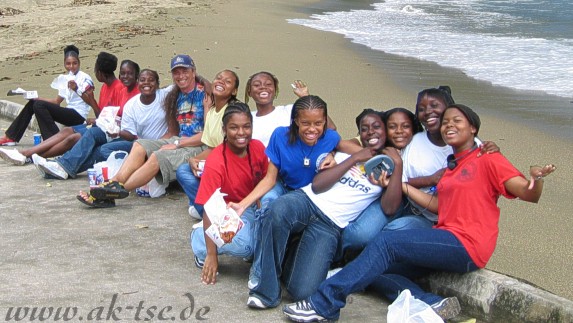
© by andre@ak-tsc.de